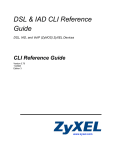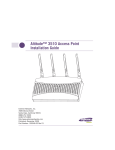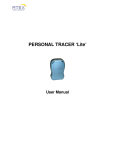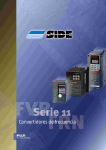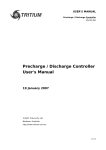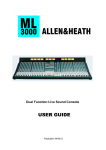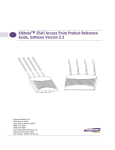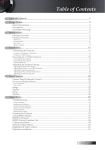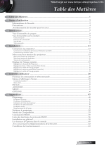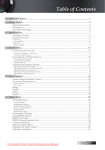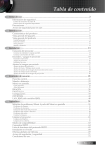Download Extreme Networks Altitude 4511 Specifications
Transcript
Extreme Networks Evaluation Guide Altitude 4511 Access Point Evaluation Guide This document will describe the industrial design and modularity, and provide step-by-step configurations for typical use cases in multi-tenant markets such as hotels. The glossary of features lists the webUI screens, along with a short description of the functionality. The highpowered radio will need to be tested by comparing the Altitude™ 4511 with other, “known” access points. When the comparison is made, the value of the Altitude 4511 will become more apparent. © 2011 Extreme Networks, Inc. All rights reserved. Do not reproduce. Extreme Networks Evaluation Guide: Altitude 4511 Access Point The Extreme Networks Altitude 4511 Access Point can change the way wireless networks are installed, while lowering the deployment and operations expense associated with a wireless network. When evaluating the Altitude 4511, take note of these three key features and their cost saving advantages: Advanced Industrial Design – “Hide-in-Plain-Sight” The Altitude 4511 access point installs in minutes anywhere a CAT 5/6 cable is located. Due to its tiny size, the Altitude 4511 will hide in plain sight; ceiling mount, tabletop, or wall surface. A patent-pending mechanical design is optimized for installation over any structured wiring CAT 5/6 wall jack. The wallplate form factor is 25mm (1 inch) thick, and flush mounted to the wall surface. The AP does not protrude into the wall cavity. This design allows for efficient heat transfer and a universal installation over any structured wiring plate. The modular design allows the end-user to add switched Ethernet ports as needed, and snap in any keystone or Leviton QuickPort® style connector to the wallplate. Scope of this Document This document will describe the industrial design and modularity, and provide step by step configurations for typical use cases in multi-tenant markets such as hotels. The glossary of features lists the webUI screens, along with a short description of the functionality. The high powered radio will need to be tested by comparing the Altitude 4511 with other, “known” access points. When the comparison is made, the value of the Altitude 4511 will become more apparent. Use Case 1: Configure a single AP as a standalone AP using the configuration overrides. Use Case 2: Use the Initial Setup Wizard to configure a Controller AP and dependent APs with one WLAN. Use Case 3: Use the configuration screens to configure a Controller AP with two WLANs; one open and one secure. VLANs will be added to WLANs and switched Ethernet ports. High-Powered 802.11a/b/g/n Radio Under the sleek exterior, the Altitude 4511 packs a 26dBm transmitter along with dual omni-directional 3dBi peak gain antennas. The AP supports either 2.4Ghz or 5.2Ghz operating bands. 2x2 multiple-input and multiple-output (MIMO) technology and support for legacy 802.11a/b/g is ideal for supporting a wide range of laptops, portable media players, tablets, mobile computers, Wi-Fi phones and wireless enabled smartphones. Controller AP The Altitude 4511 can be managed via CLI or webUI as a standalone access point. When more than one AP is installed, any single Altitude 4511 can operate as a Controller AP for a network of up to 25 Altitude 4511s. By using the hardware of an access point to run controller features, the Altitude 4511 dramatically lowers the cost of a managed, RF controller-based network for small hotels. All the features you want from an RF controller are here; firmware management, central configuration, status and statistics. Also advanced features such as fast roaming, Smart RF, and Rogue AP detection are all included in the Controller AP function. 2 © 2011 Extreme Networks, Inc. All rights reserved. Extreme Networks Evaluation Guide: Altitude 4511 Access Point Advanced Industrial Design Key Features • Keystone or Leviton QuickPort® connector • One port RJ-45 Ethernet Module, Three port RJ-45 Ethernet Module One-Port RJ-45 Ethernet Module The keystone port also accepts a one-port RJ-45 Ethernet Module. This module is supplied in the shipping box with a pigtail connector terminating in a 9-pin header. Snap in the RJ-45 connector and connect the header pin to the matching header on the back of the unit, labeled “FE1” • Snap-on installation in any location where an Ethernet cable is located Keystone Connector The snap-in port is designed to accept any keystonestyle or Leviton QuickPort® connector. These connectors are a popular mechanical form factor for RJ-11, RJ-45, F-connector and many more network and communications connectors. Snap out the blanking plug on the wallplate and snap in the connector of your choice. The latch on the keystone connector should always face toward the top of the AP. RJ-45 Ethernet Module – Supplied Three-Port RJ-45 Ethernet Module The front of the Altitude 4511 has an access cover that can be removed to expose a hidden connector. A three-port RJ-45 Ethernet Module connects to the hidden header and snaps onto the Altitude 4511 in place of the access cover. Remove the access cover by using a sharp tool to depress the latch on the bottom of the Altitude 4511. Pull the access cover up and away from the Altitude 4511. Reverse the procedure to install the three-port Ethernet Module. The Ethernet Module has three ports labeled “FE2”, “FE3”, and “FE4”. RJ-45 Connector for Ethernet or Digital Phone RJ-11 Analog POTs Connector Three Port RJ-45 Ethernet Module – Optional 3 © 2011 Extreme Networks, Inc. All rights reserved. Extreme Networks Evaluation Guide: Altitude 4511 Access Point Vital Information Before We Begin After the first login following a factory default configuration, the administrator will be prompted to change the password. Power The Altitude 4511 requires Power over Ethernet. Connect an 802.3af PoE switch or PoE midspan injector to the port labeled UP1/PoE on the back of the unit. The AP will draw between 6.5W and 9W of power depending on the number of Ethernet ports connected and the transmission speed. The AP takes three minutes to completely boot up. At two minutes, the Web server is active and will respond to a Web browser. However, the backend database will not authenticate user login for another minute. Login The Altitude 4511 can be accessed from a webUI or CLI. This guide will use the webUI login. The webUI requires the Adobe Systems flash plugin. If it is not installed, the webUI will prompt the administrator to install flash. For instructions on upgrading the system firmware, see the Appendix. Default user name: admin Default password: admin123 Default IP address: IP address assigned by DHCP client, or zero-config IP address where the last two octets in the IP address are the decimal equivalent of the last two bytes in the MAC address. Example: MAC address 00:C0:23:00:F0:0A Zero-config IP address: 169.254.240.10 To use the zero-config IP address, manually set your PC to same IP subnet. See the Appendix for further assistance converting the MAC bytes in hex to its decimal equivalent. 4 © 2011 Extreme Networks, Inc. All rights reserved. Extreme Networks Evaluation Guide: Altitude 4511 Access Point Reset Default Configuration, View Running Config Use the Operations menu to reload firmware, restart, or view the running configuration. Navigate to Operations -> Devices. Select the action from the list at the bottom of the page. Controller AP A Controller AP is any single Altitude 4511 that is configured to operate as an RF controller. The Controller AP provides a necessary set of management features required for a small facility. Key features of the Controller AP include: • Automatic adoption of dependent APs • Central configuration for all APs • Firmware upgrade on all APs • One IP address for the network management. The dependent APs are managed via a secure Layer 2 protocol. IP addresses can be assigned to dependent APs if desired • Central status and statistics for APs and connected wireless clients • IPS/IDS for rogue AP detection • SmartRF for efficient spectrum management and redundancy –– Automatic channel selection –– Automatic transmit power adjustment –– Neighbor AP recovery • Fast roaming for mobile devices • Role-based client access • Layer 2 and Layer 3 access control By default, an AP will be dependent if a Controller exists in the network. Adoption is automatic. A dependent AP obtains its configuration from a profile stored on the Controller AP. Any manual configuration changes on a dependent AP will be overwritten by the Controller upon reboot. Up to 24 dependent APs can be connected to a Controller AP. 5 © 2011 Extreme Networks, Inc. All rights reserved. Extreme Networks Evaluation Guide: Altitude 4511 Access Point Initial Setup Wizard Policies, Profiles and Adoptions The Wizard will run automatically after a factory reset. It will walk the administrator through a set of minimum required configurations. Once complete, profiles will be created and assigned to the device. To restart the Wizard, you must reset the unit to factory defaults. See the Appendix for instructions on resetting the factory default configuration. Policies The configuration screens in the Setup Wizard include: Note that there are policies inside of policies. For example, Wireless Clients can be allowed or denied access to the network based on an IP or MAC firewall policy. Thus, the Wireless Client Roles policy requires a Firewall policy. Operating Mode: Standalone AP; Controller AP; Dependent AP Basic System Info: Password, Timezone, Country, Network Access VLAN and IP Address: Set the native VLAN and member VLANs for all interfaces. Set whether the interface is an access or trunk port. Assign the IP address to the uplink LAN port. WLAN Configuration: Set up multiple WLANs and set the minimum required information such as SSID, Authentication, and VLAN. If needed, set up a RADIUS server to authenticate a WLAN. Most (but not all) configuration elements such as Firewall and WLAN are configured as a policy. Multiple policies can be created and edited. Once a policy is created, it must be mapped onto a device profile. If a policy is edited, those edited changes are automatically applied to any device mapped to that policy. Policies can be created at any time. When the administrator is presented with a drop down box to select a policy, there will always be a “create” and “edit” button to allow the additional policy to be created at that time. To keep the configuration steps clear, we recommend creating a core set of policies at the beginning. Thus, these policies will be ready for selection when the device profiles are created. Device Profiles Device Profiles are a container for policies and other configurations, and are assigned to devices either manually or by an adoption policy. Device profiles should be created for major groups of devices. For example, a typical network would have at least two profiles; one profile for the Controller AP, and one profile for all dependent APs. If APs will service distinct areas of a hotel; such as guest rooms and meeting rooms, then a unique dependent AP profile may be created for each of these unique applications. Device Overrides Note that any profile configuration can be overridden by specifically configuring the device. It is recommended that device overrides be used at a minimum. Commonly, a device override is used to assign the management IP address and default gateway to a Controller AP. Another use for device overrides is to quickly configure a standalone AP. If a device configuration is overridden, be certain to document the configuration to prevent confusion later. 6 © 2011 Extreme Networks, Inc. All rights reserved. Extreme Networks Evaluation Guide: Altitude 4511 Access Point Adoption Dependent APs are adopted by a Controller AP. By default, each AP is standalone or dependent. When a new AP is installed in the network, it will begin the network discovery process to find a Controller AP. On the Controller AP, an adoption policy can be created to control which APs are adopted. The policy rules can include MAC address, serial number, DHCP option, and other parameters. TIP Configure Policies first then map policies to Device Profiles. In a simple network, edit the “default” policy to match your requirements rather than create new policies. Policies Available for Configuration Refer to the Appendix for a description of each of these policies. The core policies that will always be configured are shown in green. Note that there are policies inside of policies. Also, some policies, notably firewall policies, can be selected in multiple screens. Policies WebUI Navigation Devices Menu Adoption Policy Profile -> <profile name> RF Domain Menu RF Domain RF Domain Wireless Menu WLANs Profile -> <profile name> -> Radio -> WLAN Mapping WLAN QoS <link to other policy> Wireless -> Wireless LAN -> Basic Configuration Radio QoS Profile -> <profile name> -> Radio -> Radio Settings Remote AAA Server <link to other policy> Wireless -> Wireless LAN -> Security Services -> Captive Portal MAC Association ACL Profile -> <profile name> -> Radio -> Radio Settings <link to other policy> wireless -> wireless lan -> firewall SmartRF <link to other policy> RF domains -> Basic Configuration Bridging Profile -> <profile name> -> General Security Menu Wireless Firewall Profile -> <profile name> -> Security -> Settings IP Firewall Profile -> <profile name> -> Interface -> Ethernet ports Profile -> <profile name> -> Interface -> Virtual Interface <link to other policy> Wireless, Wireless LAN, Firewall MAC Firewall Profile -> <profile name> -> Interface -> Ethernet ports Profile -> <profile name> -> Interface -> Virtual Interface <link to other policy> Wireless, Wireless LAN, Firewall Wireless IPS <link to other policy> RF Domains -> Basic Configuration Wireless Client Roles Profile -> <profile name> -> Security -> Services Services Menu Hotspot <link to other policy> Wireless -> Wireless LAN -> Security DNS Whitelist Services -> Captive Portal Management Menu Management Policy Profile -> <profile name> -> Management -> Settings 7 © 2011 Extreme Networks, Inc. All rights reserved. Extreme Networks Evaluation Guide: Altitude 4511 Access Point Use Case One This case will show the configuration required for a Standalone AP using the device Overrides configuration. This is the most direct method to configure a standalone AP and is ideal for conducting a site survey. Test Setup Extreme Networks equipment required: Diagnostics Configure the network and test PCs as shown in the diagram. One (1) Altitude 4511 • Verify the test PCs have the correct IP addresses Third-party equipment required: • Verify the AP actually has a WLAN associated. Use the information in the Diagnostics section to view the WLANs and wireless clients on each AP Two PCs; one upstream and one downstream. Set the PCs with a static IP address to be on the same subnet. Alternatively, connect the Altitude 4511 to a subscriber gateway and test using an Internet connection. Upstream Test PC 192.168.100.2/24 Gateway and Router DHCP Server 192.168.100.254/24 Layer 2 Network Switch Altitude 4511 Standalone Access Point Controller Configuration Password: helpme Access Method: Telnet, SSH, HTTP 192.168.100.1/24 Downstream Test PC 192.168.100.3/24 5644-01 8 © 2011 Extreme Networks, Inc. All rights reserved. Extreme Networks Evaluation Guide: Altitude 4511 Access Point Configuration Use the device Overrides configuration to configure a standalone AP. Profiles can be used, but the easier path is to directly configure the device. RF Domain Overrides webUI navigation: Configuration -> Devices -> Device Configuration -> RF Domain Overrides Select Time Zone and Country Click OK Profile Overrides webUI navigation: Configuration -> Devices -> Device Configuration -> Profile Overrides Virtual Interface with IP Click Interfaces -> Virtual Interfaces Click Add, leave the VLAN 1 name Uncheck “Use DHCP to Obtain IP” Assign an IP address, 192.168.100.1/24 Click OK, then Exit Radio and WLAN Click Interfaces -> Radios Select Radio1, click Edit Under Radio Settings Select an operating Channel. Do not select “Smart” Enter a Transmit power e.g. “24”. Do not select “Smart” Click OK Select the WLAN Mapping screen Click Create a New WLAN Enter a friendly name in the top box, Enter an SSID Click create next to the WLANQoS box. Enter a friendly name Click OK, then Exit Click OK, then Exit Select your WLAN from the right side pane, click the << arrow Click OK, then Exit Default Gateway Click Network -> Static Routes Click Add Row Enter 0.0.0.0/0 as the network address Enter 192.168.100.254 as the gateway Click OK Commit and Save Click the Commit button, then Save in the upper right corner 9 © 2011 Extreme Networks, Inc. All rights reserved. Extreme Networks Evaluation Guide: Altitude 4511 Access Point Use Case Two One WLAN will be configured with open authentication. The access points will bridge all packets and VLANs will not be used anywhere in the network. This Use Case will use the setup wizard. Reset the unit to the factory default before beginning this use case. Set static IP addresses on test PCs for this test. Test Setup 1. Reset the unit to factory defaults. Consult the Appendix for instructions 2.Connect three APs to a Layer-2 switch 3.Connect a upstream test PC to the upstream Layer-2 switch 4.To connect to the AP you wish to designate as the Controller, use the zero-conf IP address: Extreme Networks® equipment required: Two (2) or Three (3) Altitude 4511s. One will serve as the Controller for the network. • Set the upstream Test PC to a manual IP address in the 169.254.x.x network Third-party equipment required: • Convert the last two bytes of the AP MAC address to decimal (see Appendix) The uplink LAN ports of the access points can be connected to a Layer-2 network switch or to an Internet router. A PC with a wireless network card can be used to test the network. 5.When the configuration is done; set the IP address of the upstream Test PC to 192.168.100.2. Diagnostics • Verify the wireless test PC and upstream PC have IP addresses in the same subnet. • Verify the AP actually has a WLAN associated. Use the information in the Diagnostics section to view the WLANs and wireless clients on each AP Upstream Test PC 192.168.100.2/24 Layer 2 Network Switch Altitude 4511 Controller + AP Network Controller for all APs WLAN 1: Open FE1: Not Used Altitude 4511 Dependent AP Altitude 4511 Dependent AP Downstream Test PC 192.168.100.3/24 Controller Configuration IP Address: 192.168.100.1/24 Gateway: 192.168.100.1 Password: helpme Access Method: Telnet, SSH, HTTP, HTTPS 5645-01 10 © 2011 Extreme Networks, Inc. All rights reserved. Extreme Networks Evaluation Guide: Altitude 4511 Access Point Configuration The setup wizard will start on the first boot after a factory reset. To reset the AP to factory defaults, press the reset button on the bottom of the AP. Click Start Wizard Select “Controller AP” Click Next Enter a new system password Enter a location and contact. This will be used in the SNMP system OID. Select the Time Zone and Country Select the type of network access that you will allow Click Next 11 © 2011 Extreme Networks, Inc. All rights reserved. Extreme Networks Evaluation Guide: Altitude 4511 Access Point Select Bridge Mode Click Next Enter 192.168.100.1/24 as the LAN IP Click Next In this example, we will not be using the router mode. Click Next 12 © 2011 Extreme Networks, Inc. All rights reserved. Extreme Networks Evaluation Guide: Altitude 4511 Access Point Click the “Add WLAN” button Enter an SSID, select No authentication Click OK Click Next Since we are using Open authentication, RADIUS configuration is not needed. Click Commit/Next The dependent APs will be adopted by this Controller AP and will show up in the discovery list. Click Next 13 © 2011 Extreme Networks, Inc. All rights reserved. Extreme Networks Evaluation Guide: Altitude 4511 Access Point Connect a wireless Test PC to the WLAN The wireless Test PC will show up in the Wireless Client Association list Click Finish/Save Set the time or enter an NTP serve Click Finish 14 © 2011 Extreme Networks, Inc. All rights reserved. Extreme Networks Evaluation Guide: Altitude 4511 Access Point Use Case Three Two WLANs will be configured; one with open authentication and the other with a pre-shared key authentication. The access points will bridge all packets and a unique VLAN ID will be assigned to each WLAN and the Fast Ethernet port. This configuration can be done using the Wizard or the webUI policies and profiles configuration screens. Test Setup 1. Snap-in the RJ-45 module to the keystone port. Connect the pigtail on the RJ-45 module to the header on the back of the AP 2.Configure the network and test PCs as shown in the diagram Diagnostics Static IP addresses will be assigned to the test PCs. • Verify the test PCs have the correct IP addresses Extreme Networks equipment required: • Verify the AP actually has a WLAN associated. Use the information in the Diagnostics section to view the WLANs and wireless clients on each AP Two (2) or Three (3) Altitude 4511 APs. One will serve as the RF Controller for the network. One RJ-45 snap-in Ethernet Module. Third-party equipment required: A subscriber gateway that understands 802.1Q VLANs is recommended. Alternatively, a Layer-2 network switch can be configured with VLAN trunk ports and access ports. A PC with a wireless network card can be used to test the network. Gateway and Router 802.1Q VLAN Aware DHCP Server Upstream Test PC 192.168.100.2/24 Native VLAN: 5 VLANs: 5 Mode: Access Port Native VLAN: 1 VLANs: 5, 100, 200, 300 Mode: Trunk Port Layer 2 Network Switch Native VLAN: 1 VLANs: 5, 100, 200, 300 Mode: Trunk Port Altitude 4511 Controller + AP Native VLAN: 1 VLANs: 5, 100, 200, 300 Mode: Trunk Port Altitude 4511 Dependent AP Controller Configuration Mgmt IP: 192.168.100.1/24 Mgmt VLAN: 5 Password: helpme Access Method: Telnet, SSH, HTTP Native VLAN: 1 VLANs: 5, 100, 200, 300 Mode: Trunk Port Altitude 4511 Dependent AP Downstream Test PC 192.168.100.3/24 Network Configuration for All APs WLAN 1: Open, Native VLAN 200 WLAN 2: WPA PSK, Native VLAN 300 FE1: Enabled, Natvie VLAN 100, Access Port UP1: Native VLAN 1, Member VLAN 5, 100, 200 Trunk Port Management VLAN: 5 5646-01 15 © 2011 Extreme Networks, Inc. All rights reserved. Extreme Networks Evaluation Guide: Altitude 4511 Access Point Configuration Create Adoption Policy webUI navigation: Configuration -> Device -> Adoption Policy Click add Enter a name Click Continue Click add Select Match Type, any Select Profile Name “dependent-AP4511” Click OK, then Exit Create an Open WLAN webUI navigation: Configuration -> Wireless -> Wireless LAN Click add Assign a friendly name for the WLAN Enter an SSID e.g. Guest-Open Enter 200 in the VLAN pool box Click OK, then Exit Create a Secure WLAN webUI navigation: Configuration -> Wireless -> Wireless LAN Click add Assign a friendly name for the WLAN Enter an SSID e.g. Guest-Secure Enter 300 in the VLAN pool box Click OK Click Security, click WPA2-CCMP in the “Select Encryption” option Clear the Pre-Shared Key field, click the show box Enter an ASCII string between 8 and 63 characters e.g. extremenetworks Click OK Click Client Settings, uncheck Client-to-client Communication Click OK, then Exit Create SmartRF Policy webUI navigation: Configuration -> Wireless -> SmartRF (or edit the default SmartRF policy to match your settings) Click add Assign a name Leave sensitivity at Medium Check the option to Enable SmartRF policy Click OK, then Exit 16 © 2011 Extreme Networks, Inc. All rights reserved. Extreme Networks Evaluation Guide: Altitude 4511 Access Point Create a Primary Controller AP Profile webUI navigation: Configuration -> Profiles (or edit the default Controller AP Profile to match your settings) Click add Assign a name, select the ALTITUDE 4511 type Check the box to Set as Controller AP Leave adoption policy at <none> Click OK Click Interface -> Ethernet Ports Select FE1 Enter 100 as the Native VLAN Click OK, then Exit Select UP1 Set the mode to Trunk Enter 5, 100, 200, 300 in the Allowed VLANs box Click OK, then Exit Click Virtual Interfaces Click add Enter 5 in the VLAN ID box Enter management VLAN in the description Enter 10.10.10.2/24 in the IP address field Click OK, then Exit Click add Enter 100 in the VLAN ID box Enter Fast Ethernet port 1 in the description Click OK, then Exit Click add Enter 200 in the VLAN ID box Enter Open WLAN in the description Click OK, then Exit Click add Enter 300 in the VLAN ID box Enter Secure WLAN in the description Click OK, then Exit Click Radio Select radio1, click Edit Click WLAN Mapping Select your WLANS from the right side, click the arrow to map it to your radio Click OK, then Exit Click Network Select Static Routes, click Add Row Enter 0.0.0.0/0 in the Network Address field, and your router as the Gateway Click OK, then Exit 17 © 2011 Extreme Networks, Inc. All rights reserved. Extreme Networks Evaluation Guide: Altitude 4511 Access Point Click Management Select Settings, Select the default Management Policy, click the Edit button Select the access modes you wish to enable; Telnet, SSH, HTTP, HTTPS Under Access Restrictions, select “source-address” as the Filter Type In the “Source Subnets” field, enter 10.10.10.0/24 Click OK, then Exit Edit the Dependent-AP Profile webUI navigation: Configuration -> Profiles Select dependent-AP4511, click Edit Select your adoption policy from the drop down list Click OK Click Interface -> Ethernet Ports Select FE1 Enter 100 as the Native VLAN Click OK, then Exit Select UP1 Set the mode to Trunk Enter 100, 200, 300 in the Allowed VLANs box Click OK, then Exit Click add Enter 100 in the VLAN ID box Enter “Fast Ethernet port 1” in the description Click OK, then Exit Click add Enter 200 in the VLAN ID box Enter “Open WLAN” in the description Click OK, then Exit Click add Enter 300 in the VLAN ID box Enter “Secure WLAN” in the description Click OK, then Exit Click Radio Select radio1, click Edit Click WLAN Mapping Select both of your WLANS from the right side, click the arrow to map it to your radio Click OK, then Exit 18 © 2011 Extreme Networks, Inc. All rights reserved. Extreme Networks Evaluation Guide: Altitude 4511 Access Point Diagnostics Network and Access Point Statistics The Controller AP and its network of connected access points can be examined using the Statistics menu. From here, note how the list of displayed statistics will change depending if you select the RF Domain, the Controller AP, or one of the Dependent APs. To determine if a WLAN is operational, click Statistics, then select the Controller AP. Click on the “Radios” option. Note the State of the radio. In the example shown below, the radio is OFF because a WLAN has not been mapped to the radio. 19 © 2011 Extreme Networks, Inc. All rights reserved. Extreme Networks Evaluation Guide: Altitude 4511 Access Point Network View The Dashboard view provides quick status of the network and clients. One key feature of the Dashboard is the Network View where the administrator can color code the wireless clients using quality indicators. The indicators are RF Quality, Utilization, SNR, and Threat. For each indicator, a filter can be applied with Low, Medium, and High thresholds. Use the Dashboard Network View to quickly gauge the status of the wireless clients and identify if corrective action is needed. Double click on a client to see detailed statistics about the connection. 20 © 2011 Extreme Networks, Inc. All rights reserved. Extreme Networks Evaluation Guide: Altitude 4511 Access Point Common Configuration Mistakes This section will be updated during the course of the evaluation period. It will contain common configuration mistakes and the corrections recommended by Extreme Networks support. The Most Common Mistake All configurations must be committed to the Running configuration before they are active. Be sure to click the Commit button in the upper right corner of the configuration screen. If anything doesn’t appear to be working, click Commit before doing any further diagnostics. Click Save before rebooting or turning the AP off. No Default Gateway Assigned to the Management Interface Within the Controller profile, select Network -> Static Routes. Click Add Rows and enter 0.0.0.0/0 as the network address and your router IP address as the Gateway. This will set the default gateway for the system. WLAN is not Broadcasting on My Test Laptop This usually means then WLANs are not mapped to a radio. Within the Controller and Dependent AP profiles, select Interface -> Radios. Select radio1 and click Edit. Select WLAN Mapping and ensure WLANs are mapped to the radio on the left side of the box. Click OK, then exit. It may also mean the wrong country was selected. Wrong Country Selected US FCC certification requires that an access point used in the United States can only have a US country option. If the AP presents other country options in a list, the WLAN will be disabled if the AP is a US SKU. Be sure to check the label on the rear of the unit to see if you have a WR (worldwide RoHS) or a US (United States) SKU. The WR and US are appended to the end of the part number. Use the information in the Diagnostics section to view the State of the radio. 21 © 2011 Extreme Networks, Inc. All rights reserved. Extreme Networks Evaluation Guide: Altitude 4511 Access Point Glossary of Features This glossary provides a short description of key features found in the Altitude 4511 webUI. Dashboard The Dashboard provides graphical and statistics view of the network. A key feature in the dashboard allows the administrator to select from a list of critical parameters to display the network and client connectivity. Summary webUI navigation: Dashboard -> Summary details: The overall health of the network is shown in summary. Top (or worst) five access points are sorted by number of clients, RF quality, and threat index. The number of clients connected on 5.2Ghz radios and 2.4Ghz radios is displayed in this summary view. Network View webUI navigation: Dashboard -> Network View details: The network topology is displayed in a graphical view. Four key client parameters can be overlaid on the network view for a quick reference; RF Quality, Utilization, SNR, Threat. To view detailed statistics of the network, access points, and wireless clients; click on the Statistics link from the Network view. If you select an adopted AP, the Statistics link will show details for that particular AP. If you select the Controller AP, statistics will be displayed for the network. Configuration -> Devices Devices Configuration WebUI navigation: Configuration -> Devices -> Device Configuration details: Select a single device from the list of known devices. All configurations found in a policy can be overridden using this screen. It is recommended to use the policies and profiles to configure devices and use the Device override configurations sparingly. It is common to use policies for a group of devices, but use a configuration override to set a unique IP address. Additionally, if using the Altitude 4511 as a single, standalone access point, device configuration is the fastest way to configure the device. Adoption Policy webUI navigation: Configuration -> Devices -> Adoption Policy details: Device adoption can be done manually, or by creating rules. When a dependent AP is adopted by a Controller, adoption rules determine 1) whether the dependent AP is adopted by this controller and 2) what profile to assign to the AP. Adoption rules include common parameters such as MAC address, serial number and DHCP option. To manually assign an adoption policy to a device, go to the “Configuration -> Devices -> Device Configuration -> [select device in list] -> Cluster” menu. Select the policy from the drop down list. 22 © 2011 Extreme Networks, Inc. All rights reserved. Extreme Networks Evaluation Guide: Altitude 4511 Access Point To manually assign a profile to a device (bypassing all rules or manual adoption), go to the “Configuration -> Devices -> Device Configuration -> [select device in list] -> Basic Configuration” menu. Select the policy from the drop down list. Configuration -> Wireless Create policies for WLANs and related parameters required for the wireless LAN. Wireless LANs webUI navigation: Configuration -> Wireless -> Wireless LANs details: Create a WLAN policy and select access rules, QoS, firewall and VLAN policies to apply to the WLAN. Note that some policies are embedded within policies. For example, a QoS policy is required within the WLAN policy. This can lead to confusion during configuration. Anywhere a policy is required in a drop down list, there will always be a Create and Edit button. If the policy needs to be created, click the Create link next to the drop down box. WLAN QOS Policy webUI navigation: Configuration -> Wireless -> WLAN QOS Policy details: Set the WMM QOS configurations to apply to clients connecting to the WLAN. WMM QoS is applied to client packets based on DSCP bit. Radio QoS Policy webUI navigation: Configuration -> Wireless –Radio QOS details: Radio QoS applies to all packets on the radio regardless of WLAN. WLAN QoS rules will take priority. AAA Policy webUI navigation: Configuration -> Wireless -> AAA Policy details: Create multiple AAA policies with unique RADIUS servers and secret phrase. AAA policies are required for Enterprise (802.1x) client authentication. Association ACL webUI navigation: Configuration -> Wireless -> Association ACL details: Create policies to control access to the wireless LANs by filtering on the MAC address of the client. Smart RF Policy webUI navigation: Configuration -> Wireless -> Smart RF Policy details: Create one SmartRF policy for the RF domain. An RF Domain is the collection of RF spectrum management tools employed by the Altitude 4511 for efficient use of the RF spectrum. The RF Domain is a key element of a Extreme Networks management entity. Note that all APs “belong” to an RF Domain. On the Altitude 4511 Controller AP feature, there is only one RF Domain supported. To configure multiple RF Domains for a large enterprise network, use an Extreme Networks RF Controller such as the Summit® WM3400, WM3600, or WM3700. These dedicated RF Controllers feature multiple RF Domain management, along with a host of sophisticated Layer 2 and Layer 3 features. 23 © 2011 Extreme Networks, Inc. All rights reserved. Extreme Networks Evaluation Guide: Altitude 4511 Access Point SmartRF is a set of software algorithms that provides automatic transmit power adjustment, automatic channel selection, and automatic neighbor recovery if a failure occurs in a neighbor access point. On a dedicated RF Controller, SmartRF adds additional functionality for an enterprise network. Bridging Policy webUI navigation: Configuration -> Wireless -> Bridging Policy details: Set whether a common VLAN will be bridged between wired and wireless interfaces. Configuration -> Profiles Profiles are containers to hold policies and configurations. Assign profiles to devices. The administrator can create multiple profiles for different applications of the wireless access points. Most configurations will require the administrator to select a policy from a drop down list. For example, select an adoption policy from a drop down list. Other configurations will be done directly in the profile and will not be found in a policy. Examples of configurations that are not found in a policy include Fast Ethernet port configuration. These configurations will be set within the profile itself. Configuration -> RF Domains The RF Domain contains the SmartRF policy to manage the RF spectrum, and the WIPs policy for wireless security and intrusion protection. Configuration -> Security Security settings include complex firewall rules, WIPs policy, and Wireless Client Roles Firewall Policy webUI navigation: Configuration -> Security -> Firewall Policy details: Create global denial of service rules and configuration and Storm Control with ARP, Ucast, Bcast, Mcast. Advanced settings provide more detailed configuration of TCP protocol and flows. IP Firewall Rules webUI navigation: Configuration -> Security -> IP Firewall Rules details: Create multiple rules with filters based on source/destination IP address, and a set of IP protocols. Mark packets with an 802.1p bit or DSCP bit. MAC Firewall Rules webUI navigation: Configuration -> Security -> MAC Firewall Rules details: Create multiple rules with filters based on source/destination MAC address, VLAN ID, 802.1P bit. Mark packets with a 802.1p bit or DSCP bit. WIPS Policy webUI navigation: Configuration -> Security -> WIPS Policy details: Create a wireless security policy that tracks excessive network activity, client (MU) anomalies, and AP anomalies. Configure Rogue AP detection. 24 © 2011 Extreme Networks, Inc. All rights reserved. Extreme Networks Evaluation Guide: Altitude 4511 Access Point Wireless Client Roles webUI navigation: Configuration -> Security -> Wireless Client Roles details: Create filters to identify clients and apply a unique set of IP or MAC layer firewall rules. Filter options include MAC address, connected AP, SSID, Authentication and Encryption types. Configuration -> Services Captive Portals webUI navigation: Configuration -> Services -> Captive Portal details : A captive portal will redirect a client web browser to an internal web site, or an external hosted site. Client authentication can be open, or by a RADIUS policy. A walled garden can be created by entering a DNS Whitelist of allowed domains. Four internal Web pages are supported; Login, Terms and Conditions, Welcome, and Fail. For a basic captive portal, enter text into the boxes supplied. For a more custom captive portal, use an externally hosted Website or link to an externally hosted set of Web pages. DNS Whitelist webUI navigation: Configuration -> Services -> DNS Whitelist details : Enter domains that will be allowed in the captive portal prior to authentication. A client that has not authenticated via the captive portal can access websites in the DNS whitelist. Configuration -> Management Create management policies for customizing the management access rights and password authentication. Note that an External RADIUS server authentication is supported. Generally, one management policy is all that is required. Diagnostics Create filter rules to display network events. Filters can be set by severity and source MAC address. MAC addresses can be a radio BSS or a client MAC address. Core and panic snapshots and UI logs may be requested by Extreme Networks customer support for remote diagnostics Operations Use the Operations menu to reset the AP to factory defaults, or reboot the AP to make changes effective. This screen will generate the startup and running configuration files for debugging and configuration diagnostics. Device Details webUI navigation: Operations -> Device Details details: Displays the Primary and Secondary firmware and allows the administrator to select which firmware to use. 25 © 2011 Extreme Networks, Inc. All rights reserved. Extreme Networks Evaluation Guide: Altitude 4511 Access Point File Transfers webUI navigation: Operations -> File Transfers details: Use this menu to upload firmware and configuration files to and from the access point. Click on the Advanced tab to select TFTP, FTP, SFTP, or HTTP and select the logical port number to use. File Browser webUI navigation: Operations -> File Browser details: Use this menu to browse the file system and view files that have been saved to the access point Statistics Statistics are collected and displayed for the RF Domain, the Controller AP, and individual Dependent APs. Depending on what is selected, a different set of statistics are displayed. One of the most useful statistics is the RF Domain -> SmartRF History. This view will show the actions of the SmartRF feature in the network. To view a list of wireless clients, click on the Controller AP and select Wireless Clients. 26 © 2011 Extreme Networks, Inc. All rights reserved. Extreme Networks Evaluation Guide: Altitude 4511 Access Point Appendix LED Behavior The Altitude 4511 has two LEDs to display device status. The green LED is used to indicate 2.4Ghz operation and the Amber LED is used to indicate 5Ghz operation. You will note that the opposite LED will be used to indicate other states. For example, if operating in 2.4Ghz bands, the Green LED will indicate activity while the Amber LED will indicate state. The following acronyms are used in the table: CAP = controller AP DAP = dependent AP Standalone = individual AP managed by itself State Description 1 AP is booting up 2 DAP that is not adopted; or does not have a profile 3 DAP that is adopted and functioning 4 DAP that WAS adopted, but the Controller has died. AP retains previous config 5 CAP (controller AP) or Standalone AP that is functioning 6 CAP or Standalone that is not configured State Green LED Amber LED 1 Solid Solid 2 Solid Solid 3 Blink with activity if 2.4Ghz; else off Blink with activity if 5Ghz; else off 4 Blink with activity if 2.4Ghz; else on Solid Blink with activity if 5Ghz; else on Solid 5 Blink with activity if 2.4Ghz; else on Solid Blink with activity if 2.4Ghz; else on Solid 6 Solid Solid 27 © 2011 Extreme Networks, Inc. All rights reserved. Extreme Networks Evaluation Guide: Altitude 4511 Access Point Convert a MAC Address Into its ZeroConf IP Address Equivalent For example: MAC address 00:C0:23:00:F0:0A Zero-conf IP address equivalent: 169.254.240.10 The last two bytes of the MAC address will become the last two octets of the zero-conf IP address. Use Windows Calculator to convert Hex to Decimal Select View -> Scientific Click “Hex” Enter the hex byte, e.g. F0 Click “Dec” 28 © 2011 Extreme Networks, Inc. All rights reserved. Extreme Networks Evaluation Guide: Altitude 4511 Access Point Reset to Factory Defaults There are two ways to reset the unit to factory defaults. To revert to factory default configuration using the hardware reset button on the bottom of the unit: From the webUI, navigate to the Operations main menu. Select Reset (factory default) from the menu at the bottom of the page. Click Execute. 1. Remove power from the AP 2.Using a paper clip, press and hold the reset button on the back of the unit. The reset button is located on the serial label, below the words “part number” 3.Apply power by connecting a PoE source 4.The amber LED will blink slow three times 5.When ithe Amber LED blinks fast, release the button 6.The AP will continue to boot in its default configuration state 29 © 2011 Extreme Networks, Inc. All rights reserved. Extreme Networks Evaluation Guide: Altitude 4511 Access Point Upgrade the Firmware Click on Operations -> Devices. Select the AP on the left side. Click the Upgrade Firmware button in the lower right corner. Enter the TFTP or FTP URL and path. For an easier data entry, click the Advanced option to enter the IP address, user name, password, and path in separate entry boxes. When the upgrade is complete, note the firmware versions and the Next Boot image. Select Restart from the menu in the lower left corner. Click Execute. Corporate and North America Extreme Networks, Inc. 3585 Monroe Street Santa Clara, CA 95051 USA Phone +1 408 579 2800 Europe, Middle East, Africa and South America Phone +31 30 800 5100 Asia Pacific Phone +65 6836 5437 Japan Phone +81 3 5842 4011 www.extremenetworks.com © 2011 Extreme Networks, Inc. All rights reserved. Extreme Networks, the Extreme Networks Logo and Altitude are either registered trademarks or trademarks of Extreme Networks, Inc. in the United States and/or other countries. All other trademarks are the trademarks of their respective owners. Specifications are subject to change without notice. 1811_01 09/11































